Decadal Ocean Heat Redistribution Since the Late 1990s and Its Association with Key Climate Modes
Abstract
1. Introduction
- (1)
- Uncertainties in OHC products, which are not fully accounted for in previous studies related to SWS. They were substantial differences among OHC datasets [26,44,45], which is one reason for the debate. Recently, progress has been made to understand the error in OHC estimates and improve the OHC record [29,46,47,48]. This progress will be discussed in Section 3 and will allow for a better identification of the OHC change during the SWS period.
- (2)
- On a decadal scale, natural variability in OHC records are mixed with forced changes by GHGs (manifested by a long-term warming trend in OHC), aerosols, ozone, volcanoes (manifested by a several-years decrease in OHC records) etc. [32,49,50,51,52,53]. Therefore, one has to separate the natural variability related to SWS from other changes such as a long-term anthropogenic warming signals. One method is to use climate models [32], but the short-coming of this approach is the model error at the ocean subsurface [54,55], resulting in some inconsistency among model-based studies [43,51,56]. This study used a simple method accounting for the forced changes (will be introduced in Section 2) the results will be shown in Section 3.
2. Data and Method
3. Results
3.1. Improving the OHC Record
3.2. Observed Regional OHC Changes
3.3. OHC Heat Redistribution Linked to Surface Decadal Modes
3.3.1. ENSO
3.3.2. PDO
3.3.3. AMO
4. Discussion
5. Concluding Remarks
- (1).
- The community should be clearer about the uncertainty in OHC. There are many lessons learned from the discrepancy of the different published analyses due to the uncertainty in OHC records. In the future, it will be helpful to quantify the signal versus error in OHC records at different temporal and spatial scales.
- (2).
- How do different climate modes impact the ocean heat uptake? Our observational analyses provide an ability to answer this question, but the caveat is that the record is still too short: i.e., the typical period of AMO and PDO is 30~70 years, similar to the length of the reliable OHC record (~60 years since the late 1950s). Combined analyses of models and observations are the proposed way forward.
Author Contributions
Funding
Acknowledgments
Conflicts of Interest
References
- Hartmann, D.L.; Tank, A.M.G.K.; Rusticucci, M.; Alexander, L.V.; Brönnimann, S.; Charabi, Y.; Dentener, F.J.; Dlugokencky, E.J.; Easterling, D.R.; Kaplan, A.; et al. Observations: Atmosphere and surface. In Climate Change 2013: The Physical Science Basis. Contribution of Working Group I to the Fifth Assessment Report of the Intergovernmental Panel on Climate Change; Stocker, T.F., Qin, D., Plattner, G.-K., Tignor, M., Allen, S.K., Boschung, J., Nauels, A., Xia, Y., Bex, V., Midgley, P.M., Eds.; Cambridge University Press: Cambridge, UK; New York, NY, USA, 2013; pp. 159–254. [Google Scholar]
- Meehl, G.A.; Arblaster, J.M.; Fasullo, J.Y.; Hu, A.; Trenberth, K.E. Model-based evidence of deep-ocean heat uptake during surface-temperature hiatus periods. Nat. Clim. Chang. 2011, 1, 360–364. [Google Scholar] [CrossRef]
- Trenberth, K.E.; Fasullo, J.T. An apparent hiatus in global warming? Earth’s Future 2013, 1, 19–32. [Google Scholar] [CrossRef]
- Kosaka, Y.; Xie, S.-P. Recent global-warming hiatus tied to equatorial Pacific surface cooling. Nature 2013, 501, 403. [Google Scholar] [CrossRef] [PubMed]
- Fyfe, J.C.; Meehl, G.A.; England, M.H.; Mann, M.E.; Santer, B.D.; Flato, G.M.; Hawkins, E.; Gillett, N.P.; Xie, S.-P.; Kosaka, Y.; et al. Making sense of the early-2000s warming slowdown. Nat. Clim. Chang. 2016, 6, 224. [Google Scholar] [CrossRef]
- Yan, X.-H.; Boyer, T.; Trenberth, K.; Karl, T.R.; Xie, S.-P.; Nieves, V.; Tung, K.-K.; Roemmich, D. The global warming hiatus: Slowdown or redistribution? Earth’s Future 2016, 4, 472–482. [Google Scholar] [CrossRef]
- Held, I.M. CLIMATE SCIENCE The cause of the pause. Nature 2013, 501, 318–319. [Google Scholar] [CrossRef] [PubMed]
- Yao, S.-L.; Luo, J.-J.; Huang, G.; Wang, P. Distinct global warming rates tied to multiple ocean surface temperature changes. Nat. Clim. Chang. 2017, 7, 486. [Google Scholar] [CrossRef]
- IPCC. Climate Change 2013: The Physical Science Basis. In Intergovernmental Panel on Climate Change; Stocker, T.F., Ed.; Cambridge University Press: Cambridge, UK, 2013. [Google Scholar]
- USGCRP. Climate Science Special Report: Fourth National Climate Assessment, Volume I; Wuebbles, D.J., Fahey, D.W., Hibbard, K.A., Dokken, D.J., Stewart, B.C., Maycock, T.K., Eds.; U.S. Global Change Research Program: Washington, DC, USA, 2017; 470p. [Google Scholar]
- Karl, T.R.; Arguez, A.; Huang, B.; Lawrimore, J.H.; McMahon, J.R.; Menne, M.J.; Peterson, T.C.; Vose, R.S.; Zhang, H.-M. Possible artifacts of data biases in the recent global surface warming hiatus. Science 2015, 348, 1469–1472. [Google Scholar] [CrossRef] [PubMed]
- Foster, G.; Abraham, J. Lack of evidence for a slowdown in global temperature. US Clim. Var. Predict. Program 2015, 13, 6–9. [Google Scholar]
- Niamh, C.; Stefan, R.; Andrew, C.P. Change points of global temperature. Environ. Res. Lett. 2015, 10, 084002. [Google Scholar]
- Lewandowsky, S.; Risbey, J.S.; Oreskes, N. The “Pause” in Global Warming: Turning a Routine Fluctuation into a Problem for Science. Bull. Am. Meteorol. Soc. 2016, 97, 723–733. [Google Scholar] [CrossRef]
- Lewandowsky, S.; Risbey, J.S.; Oreskes, N. On the definition and identifiability of the alleged “hiatus” in global warming. Sci. Rep. 2015, 5, 16784. [Google Scholar] [CrossRef] [PubMed]
- Medhaug, I.; Stolpe, M.B.; Fischer, E.M.; Knutti, R. Reconciling controversies about the ‘global warming hiatus’. Nature 2017, 545, 41. [Google Scholar] [CrossRef] [PubMed]
- Hansen, J.; Sato, M.; Kharecha, P.; von Schuckmann, K. Earth’s energy imbalance and implications. Atmos. Chem. Phys. 2011, 11, 13421–13449. [Google Scholar] [CrossRef]
- Trenberth, K.; Fasullo, J.; Balmaseda, M. Earth’s Energy Imbalance. J. Clim. 2014, 27, 3129–3144. [Google Scholar] [CrossRef]
- Mann, M.E.; Zhang, Z.; Hughes, M.K.; Bradley, R.S.; Miller, S.K.; Rutherford, S.; Ni, F. Proxy-based reconstructions of hemispheric and global surface temperature variations over the past two millennia. Proc. Natl. Acad. Sci. USA 2008, 105, 13252–13257. [Google Scholar] [CrossRef] [PubMed]
- Johnson, G.C.; Lyman, J.M.; Boyer, T.; Cheng, L.; Domingues, C.M.; Gilson, J.; Ishii, M.; Killick, R.; Monselan, D.; Wijffels, S. Ocean heat content. In State of the Climate in 2017, Global Oceans. Bull. Am. Meteorol. Soc. 2018, 99, S72–S77. [Google Scholar]
- Nerem, R.S.; Beckley, B.D.; Fasullo, J.T.; Hamlington, B.D.; Masters, D.; Mitchum, G.T. Climate-change–driven accelerated sea-level rise detected in the altimeter era. Proc. Natl. Acad. Sci. USA 2018, 115, 2022–2025. [Google Scholar] [CrossRef] [PubMed]
- Shepherd, A.; Ivins, E.R.; Geruo, A.; Barletta, V.R.; Bentley, M.J.; Bettadpur, S.; Briggs, K.H.; Bromwich, D.H.; Forsberg, R.; Galin, N.; et al. A Reconciled Estimate of Ice-Sheet Mass Balance. Science 2012, 338, 1183–1189. [Google Scholar] [CrossRef] [PubMed]
- Durack, P.; Wijffels, S.E.; Matear, R.J. Ocean Salinities Reveal Strong Global Water Cycle Intensification During 1950 to 2000. Science 2012, 336, 455. [Google Scholar] [CrossRef] [PubMed]
- Rahmstorf, S.; Box, J.; Feulner, G.; Mann, M.; Robinson, A.; Rutherford, S.; Schaffernicht, E. Exceptional twentieth-Century slowdown in Atlantic Ocean overturning circulation. Nat. Clim. Chang. 2015, 5, 475–480. [Google Scholar] [CrossRef]
- Trenberth, K.E.; Cheng, L.; Jacobs, P.; Zhang, Y.; Fasullo, J. Hurricane Harvey Links to Ocean Heat Content and Climate Change Adaptation. Earth’s Future 2018, 6, 730–744. [Google Scholar] [CrossRef]
- Rhein, M.; Rintoul, S.R.; Aoki, S.; Campos, E.; Chambers, D.; Feely, R.A.; Gulev, S.; Johnson, G.C.; Josey, S.A.; Kostianoy, A.; et al. Observations: Ocean. In Climate Change 2013: The Physical Science Basis. Contribution of Working Group I to the Fifth Assessment Report of the Intergovernmental Panel on Climate Change; Stocker, T.F., Qin, D., Plattner, G.-K., Tignor, M., Allen, S.K., Boschung, J., Nauels, A., Xia, Y., Bex, V., Midgley, P.M., Eds.; Cambridge University Press: Cambridge, UK; New York, NY, USA, 2013. [Google Scholar]
- Cheng, L.; Trenberth, K.E.; Fasullo, J.; Abraham, J.; Boyer, T.P.; Schuckmann, K.V.; Zhu, J. Taking the pulse of the planet. EOS 2018, 98, 14–15. [Google Scholar] [CrossRef]
- von Schuckmann, K.; Palmer, M.D.; Trenberth, K.E.; Cazenave, A.; Chambers, D.; Champollion, N.; Hansen, J.; Josey, S.A.; Loeb, N.; Mathieu, P.P.; et al. An imperative to monitor Earth’s energy imbalance. Nat. Clim. Chang. 2016, 6, 138–144. [Google Scholar] [CrossRef]
- Cheng, L.; Trenberth, K.; Fasullo, J.; Boyer, T.; Abraham, J.; Zhu, J. Improved estimates of ocean heat content from 1960–2015. Sci. Adv. 2017, 3, e1601545. [Google Scholar] [CrossRef] [PubMed]
- Roemmich, D.; Church, J.; Gilson, J.; Monselesan, D.; Sutton, P.; Wijffels, S. Unabated planetary warming and its ocean structure since 2006. Nat. Clim. Chang. 2015, 5, 240. [Google Scholar] [CrossRef]
- Balmaseda, M.A.; Trenberth, K.E.; Källén, E. Distinctive climate signals in reanalysis of global ocean heat content. Geophys. Res. Lett. 2013, 40, 1754–1759. [Google Scholar] [CrossRef]
- Liu, W.; Xie, S.-P.; Lu, J. Tracking ocean heat uptake during the surface warming hiatus. Nat. Commun. 2016, 7, 10926. [Google Scholar] [CrossRef] [PubMed]
- Gleckler, P.J.; Durack, P.J.; Stouffer, R.J.; Johnson, G.C.; Forest, C.E. Industrial-era global ocean heat uptake doubles in recent decades. Nat. Clim. Chang. 2016, 6, 394–398. [Google Scholar] [CrossRef]
- Foster, G.; Rahmstorf, S. Global temperature evolution 1979–2010. Environ. Res. Lett. 2011, 6, 044022. [Google Scholar] [CrossRef]
- Power, S.; Casey, T.; Folland, C.; Colman, A.; Mehta, V. Inter-decadal modulation of the impact of ENSO on Australia. Clim. Dyn. 1999, 15, 319–324. [Google Scholar] [CrossRef]
- Kushnir, Y. Interdecadal Variations in North Atlantic Sea Surface Temperature and Associated Atmospheric Conditions. J. Clim. 1994, 7, 141–157. [Google Scholar] [CrossRef]
- Yao, S.-L.; Huang, G.; Wu, R.; Qu, X. The global warming hiatus—A natural product of interactions of a secular warming trend and a multi-decadal oscillation. Theor. Appl. Climatol. 2016, 123, 349–360. [Google Scholar] [CrossRef]
- England, H.M.; McGregor, S.; Spence, P.; Meehl, G.A.; Timmermann, A.; Cai, W.; Gupta, A.S.; McPhaden, M.J.; Purich, A.; Santoso, A. Recent intensification of wind-driven circulation in the Pacific and the ongoing warming hiatus. Nat. Clim. Chang. 2014, 4, 222. [Google Scholar] [CrossRef]
- Chen, X.; Tung, K.K. Varying planetary heat sink led to global-warming slowdown and acceleration. Science 2014, 345, 897–903. [Google Scholar] [CrossRef] [PubMed]
- Liu, W.; Xie, S.-P. An Ocean View of the Global Surface Warming Hiatus. Oceanography 2018, 31. [Google Scholar] [CrossRef]
- Palmer, M.D.; McNeall, D.J. Internal variability of Earth’s energy budget simulated by CMIP5 climate models. Environ. Res. Lett. 2014, 9, 034016. [Google Scholar] [CrossRef]
- Lee, S.; Park, W.; Baringer, M.; Gordon, A.; Huber, B.; Liu, Y. Pacific origin of the abrupt increase in Indian Ocean heat content during the warming hiatus. Nat. Geosci. 2015, 8, 445–449. [Google Scholar] [CrossRef]
- Drijfhout, S.S.; Blaker, A.T.; Josey, S.A.; Nurser, A.J.G.; Sinha, B.; Balmaseda, M.A. Surface warming hiatus caused by increased heat uptake across multiple ocean basins. Geophys. Res. Lett. 2015, 41, 7868–7874. [Google Scholar] [CrossRef]
- Palmer, M.D.; Roberts, C.D.; Balmaseda, M.; Chang, Y.-S.; Chepurin, G.; Ferry, N.; Fujii, Y.; Good, S.A.; Guinehut, S.; Haines, K.; et al. Ocean heat content variability and change in an ensemble of ocean reanalyses. Clim. Dyn. 2015, 49, 909–930. [Google Scholar] [CrossRef]
- Wang, G.; Cheng, L.; Abraham, J.; Li, C. Consensuses and discrepancies of basin-scale ocean heat content changes in different ocean analyses. Clim. Dyn. 2017, 50, 2471–2487. [Google Scholar] [CrossRef]
- Cheng, L.; Abraham, J.; Goni, G.; Boyer, T.; Wijffels, S.; Cowley, R.; Gouretski, V.; Reseghetti, F.; Kizu, S.; Dong, S.; et al. XBT Science: Assessment of Instrumental Biases and Errors. Bull. Am. Meteorol. Soc. 2016, 97, 924–933. [Google Scholar]
- Ishii, M.; Fukuda, Y.; Hirahara, S.; Yasui, S.; Suzuki, T.; Sato, K. Accuracy of Global Upper Ocean Heat Content Estimation Expected from Present Observational Data Sets. SOLA 2017, 13, 163–167. [Google Scholar]
- Boyer, T.; Domingues, C.; Good, S.; Johnson, G.; Lyman, J.; Ishii, M.; Gourestki, V.; Bindoff, N.; Church, J.; Cowley, R.; et al. Sensitivity of Global Ocean Heat Content Estimates to Mapping Methods, XBT Bias Corrections, and Baseline Climatology. J. Clim. 2016, 29, 4817–4842. [Google Scholar] [CrossRef]
- Fasullo, J.T.; Nerem, R.S.; Hamlington, B. Is the detection of accelerated sea level rise imminent? Sci. Rep. 2016, 6, 31245. [Google Scholar] [CrossRef] [PubMed]
- Shi, J.-R.; Xie, S.-P.; Talley, L.D. Evolving Relative Importance of the Southern Ocean and North Atlantic in Anthropogenic Ocean Heat Uptake. J. Clim. 2018, 31, 7459–7479. [Google Scholar] [CrossRef]
- Maher, N.; Sen Gupta, A.; England, M.H. Drivers of decadal hiatus periods in the 20th and 21st centuries. Geophys. Res. Lett. 2014, 41, 5978–5986. [Google Scholar] [CrossRef]
- Gregory, J.M.; Bi, D.; Collier, M.A.; Dix, M.R.; Hirst, A.C.; Hu, A.; Huber, M.; Knutti, R.; Marsland, S.J.; Meinshausen, M.; et al. Climate models without preindustrial volcanic forcing underestimate historical ocean thermal expansion. Geophys. Res. Lett. 2013, 40, 1600–1604. [Google Scholar] [CrossRef]
- Thompson, D.W.J.; Solomon, S.; Kushner, P.J.; England, M.H.; Grise, K.M.; Karoly, D.J. Signatures of the Antarctic ozone hole in Southern Hemisphere surface climate change. Nat. Geosci. 2011, 4, 741. [Google Scholar] [CrossRef]
- Sen Gupta, A.; Jourdain, N.C.; Brown, J.N.; Monselesan, D. Climate Drift in the CMIP5 Models. J. Clim. 2013, 26, 8597–8615. [Google Scholar] [CrossRef]
- Mayer, M.; Fasullo, J.T.; Trenberth, K.E.; Haimberger, L. ENSO-driven energy budget perturbations in observations and CMIP models. Clim. Dyn. 2016, 47, 4009–4029. [Google Scholar] [CrossRef]
- Gastineau, G.; Friedman, A.R.; Khodri, M.; Vialard, J. Global ocean heat content redistribution during the 1998–2012 Interdecadal Pacific Oscillation negative phase. Clim. Dyn. 2018. [Google Scholar] [CrossRef]
- Cheng, L.; Zhu, J. Benefits of CMIP5 Multimodel Ensemble in Reconstructing Historical Ocean Subsurface Temperature Variations. J. Clim. 2016, 29, 5393–5416. [Google Scholar] [CrossRef]
- Abraham, J.P.; Baringer, M.; Bindoff, N.L.; Boyer, T.; Cheng, L.J.; Church, J.A.; Conroy, J.L.; Domingues, C.M.; Fasullo, J.T.; Gilson, J.; et al. A Review of Global Ocean Temperature Observations: Implications for Ocean Heat Content Estimates and Climate Change. Rev. Geophys. 2013, 51, 450–483. [Google Scholar] [CrossRef]
- Lyman, J.M.; Good, S.A.; Gouretski, V.V.; Ishii, M.; Johnson, G.C.; Palmer, M.D.; Smith, D.M.; Willis, J.K. Robust warming of the global upper ocean. Nature 2010, 465, 334–337. [Google Scholar] [CrossRef] [PubMed]
- Levitus, S.; Antonov, J.I.; Boyer, T.P.; Baranova, O.K.; Garcia, H.E.; Locarnini, R.A.; Mishonov, A.V.; Reagan, J.R.; Seidov, D.; Yarosh, E.S.; et al. World ocean heat content and thermosteric sea level change (0–2000 m), 1955–2010. Geophys. Res. Lett. 2012, 39. [Google Scholar] [CrossRef]
- Ishii, M.; Kimoto, M.; Kachi, M. Historical ocean subsurface temperature analysis with error estimates. Mon. Weather Rev. 2003, 131, 51–73. [Google Scholar] [CrossRef]
- Nieves, V.; Willis, J.K.; Patzert, W.C. Recent hiatus caused by decadal shift in Indo-Pacific heating. Science 2015, 349, 532–535. [Google Scholar] [CrossRef] [PubMed]
- Liu, W.; Xie, S.-P.; Lu, J. Correspondence: Reply to: ‘Correspondence: Variations in ocean heat uptake during the surface warming hiatus’. Nat. Commun. 2016, 7, 12542. [Google Scholar] [CrossRef] [PubMed]
- Chen, X.; Tung, K.-K. Correspondence: Variations in ocean heat uptake during the surface warming hiatus. Nat. Commun. 2016, 7, 12541. [Google Scholar] [CrossRef] [PubMed]
- Good, S.A.; Martin, M.J.; Rayner, N.A. EN4: Quality controlled ocean temperature and salinity profiles and monthly objective analyses with uncertainty estimates. J. Geophys. Res. Oceans 2013, 118, 6704–6716. [Google Scholar] [CrossRef]
- Trenberth, K.E.; Shea, D.J. Atlantic hurricanes and natural variability in 2005. Geophys. Res. Lett. 2006, 33. [Google Scholar] [CrossRef]
- Palmer, M.D.; Boyer, T.; Cowley, R.; Kizu, S.; Reseghetti, F.; Suzuki, T.; Thresher, A. An algorithm for classifying unknown expendable bathythermograph (XBT) instruments based on existing metadata. J. Atmos. Ocean. Tech. 2018, 35. [Google Scholar] [CrossRef]
- Ishii, M.; Kimoto, M. Reevaluation of historical ocean heat content variations with time-varying XBT and MBT depth bias corrections. J. Oceanogr. 2009, 65, 287–299. [Google Scholar] [CrossRef]
- Cheng, L.; Luo, H.; Boyer, T.; Cowley, R.; Abraham, J.; Gouretski, V.; Reseghetti, F.; Zhu, J. How well can we correct systematic errors in historical XBT data? J. Atmos. Ocean. Technol. 2018, 35, 1103–1125. [Google Scholar] [CrossRef]
- Cheng, L.; Zhu, J.; Cowley, R.; Boyer, T.; Wijffels, S. Time, Probe Type and Temperature Variable Bias Corrections to Historical Expendable Bathythermograph Observations. J. Atmos. Ocean. Technol. 2014, 31, 1793–1825. [Google Scholar] [CrossRef]
- Levitus, S.; Antonov, J.I.; Boyer, T.P.; Locarnini, R.A.; Garcia, H.E.; Mishonov, A.V. Global ocean heat content 1955-2008 in light of recently revealed instrumentation problems. Geophys. Res. Lett. 2009, 36, 471–478. [Google Scholar] [CrossRef]
- Gouretski, V.; Reseghetti, F. On depth and temperature biases in bathythermograph data: Development of a new correction scheme based on analysis of a global ocean database. Deep-Sea Res. Part I Oceanogr. Res. Pap. 2010, 57, 812–833. [Google Scholar] [CrossRef]
- Lyman, J.M.; Johnson, G.C. Estimating Annual Global Upper-Ocean Heat Content Anomalies despite Irregular In Situ Ocean Sampling. J. Clim. 2008, 21, 5629–5641. [Google Scholar] [CrossRef]
- Durack, P.; Gleckler, P.J.; Landerer, F.; Taylor, K.E. Quantifying underestimates of long-term upper-ocean warming. Nat. Clim. Chang. 2014, 4, 999–1005. [Google Scholar] [CrossRef]
- Cheng, L.; Zhu, J. Artifacts in variations of ocean heat content induced by the observation system changes. Geophys. Res. Lett. 2014, 20, 7276–7283. [Google Scholar] [CrossRef]
- Gille, S.T. Decadal-scale temperature trends in the Southern Hemisphere ocean. J. Clim. 2008, 21, 4749–4765. [Google Scholar] [CrossRef]
- Swart, N.C.; Gille, S.T.; Fyfe, J.C.; Gillett, N.P. Recent Southern Ocean warming and freshening driven by greenhouse gas emissions and ozone depletion. Nat. Geosci. 2018, 11, 836. [Google Scholar] [CrossRef]
- Frölicher, T.L.; Sarmiento, J.L.; Paynter, D.J.; Dunne, J.P.; Krasting, J.P.; Winton, M. Dominance of the Southern Ocean in Anthropogenic Carbon and Heat Uptake in CMIP5 Models. J. Clim. 2014, 28, 862–886. [Google Scholar] [CrossRef]
- Marshall, J.; Speer, K. Closure of the meridional overturning circulation through Southern Ocean upwelling. Nat. Geosci. 2012, 5, 171. [Google Scholar] [CrossRef]
- Li, Y.; Han, W.; Zhang, L. Enhanced Decadal Warming of the Southeast Indian Ocean During the Recent Global Surface Warming Slowdown. Geophys. Res. Lett. 2017, 44, 9876–9884. [Google Scholar] [CrossRef]
- McGregor, S.; Timmermann, A.; Stuecker, M.F.; England, M.H.; Merrifield, M.; Jin, F.-F.; Chikamoto, Y. Recent Walker circulation strengthening and Pacific cooling amplified by Atlantic warming. Nat. Clim. Chang. 2014, 4, 888. [Google Scholar] [CrossRef]
- Li, X.; Xie, S.-P.; Gille, S.T.; Yoo, C. Atlantic-induced pan-tropical climate change over the past three decades. Nat. Clim. Chang. 2015, 6, 275. [Google Scholar] [CrossRef]
- Robson, J.; Ortega, P.; Sutton, R. A reversal of climatic trends in the North Atlantic since 2005. Nat. Geosci. 2016, 9, 513–517. [Google Scholar] [CrossRef]
- Piecuch, C.G.; Ponte, R.M.; Little, C.M.; Buckley, M.W.; Fukumori, I. Mechanisms underlying recent decadal changes in subpolar North Atlantic Ocean heat content. J. Geophys. Res. Oceans 2017, 122, 7181–7197. [Google Scholar] [CrossRef]
- Jackson, L.C.; Peterson, K.A.; Roberts, C.D.; Wood, R.A. Recent slowing of Atlantic overturning circulation as a recovery from earlier strengthening. Nat. Geosci. 2016, 9, 518. [Google Scholar] [CrossRef]
- Wijffels, S.; Roemmich, D.; Monselesan, D.; Church, J.; Gilson, J. Ocean temperatures chronicle the ongoing warming of Earth. Nat. Clim. Chang. 2016, 6, 116. [Google Scholar] [CrossRef]
- Liu, W.; Lu, J.; Xie, S.-P.; Fedorov, A. Southern Ocean Heat Uptake, Redistribution, and Storage in a Warming Climate: The Role of Meridional Overturning Circulation. J. Clim. 2018, 31, 4727–4743. [Google Scholar] [CrossRef]
- Trenberth, K.; Caron, M.; Stepaniak, D.; Worley, S. Evolution of El Niño–Southern Oscillation and global atmospheric surface temperatures. J. Geophys. Res. Atmos. 2002, 107, AAC 5-1–AAC 5-17. [Google Scholar] [CrossRef]
- Cheng, L.; Zheng, F.; Zhu, J. Distinctive ocean interior changes during the recent warming slowdown. Sci. Rep. 2015, 5, 14346. [Google Scholar] [CrossRef] [PubMed]
- Cheng, L.; Trenberth, K.E.; Fasullo, J.T.; Mayer, M.; Balmaseda, M.A.; Zhu, J. Evolution of ocean heat content related to ENSO. J. Clim. 2018. submitted. [Google Scholar]
- McPhaden, M.J. Playing hide and seek with El Niño. Nat. Clim. Chang. 2015, 5, 791. [Google Scholar] [CrossRef]
- Newman, M.; Alexander, M.A.; Ault, T.R.; Cobb, K.M.; Deser, C.; Lorenzo, E.D.; Mantua, N.J.; Miller, A.J.; Minobe, S.; Nakamura, H.; et al. The Pacific Decadal Oscillation, Revisited. J. Clim. 2016, 29, 4399–4427. [Google Scholar] [CrossRef]
- Hu, Z.; Hu, A.; Hu, Y. Contributions of Interdecadal Pacific Oscillation and Atlantic Multidecadal Oscillation to Global Ocean Heat Content Distribution. J. Clim. 2018, 31, 1227–1244. [Google Scholar] [CrossRef]
- Trenberth, K.E.; Fasullo, J.T.; Branstator, G.; Phillips, A.S. Seasonal aspects of the recent pause in surface warming. Nat. Clim. Chang. 2014, 4, 911–916. [Google Scholar] [CrossRef]
- Delworth, T.L.; Mann, M.E. Observed and simulated multidecadal variability in the Northern Hemisphere. Clim. Dyn. 2000, 16, 661–676. [Google Scholar] [CrossRef]
- Zhang, R. Coherent surface-subsurface fingerprint of the Atlantic meridional overturning circulation. Geophys. Res. Lett. 2008, 35. [Google Scholar] [CrossRef]
- Känel, L.; Frölicher, T.L.; Gruber, N. Hiatus-like decades in the absence of equatorial Pacific cooling and accelerated global ocean heat uptake. Geophys. Res. Lett. 2017, 44, 7909–7918. [Google Scholar] [CrossRef]
- Watanabe, M.; Kamae, Y.; Yoshimori, M.; Oka, A.; Sato, M.; Ishii, M.; Mochizuki, T.; Kimoto, M. Strengthening of ocean heat uptake efficiency associated with the recent climate hiatus. Geophys. Res. Lett. 2013, 40, 3175–3179. [Google Scholar] [CrossRef]
- Xie, S.-P.; Kosaka, Y.; Okumura, Y.M. Distinct energy budgets for anthropogenic and natural changes during global warming hiatus. Nat. Geosci. 2015, 9, 29. [Google Scholar] [CrossRef]
- Hedemann, C.; Mauritsen, T.; Jungclaus, J.; Marotzke, J. The subtle origins of surface-warming hiatuses. Nat. Clim. Chang. 2017, 7, 336–339. [Google Scholar] [CrossRef]
- Hu, S.; Fedorov, A.V. The extreme El Niño of 2015–2016 and the end of global warming hiatus. Geophys. Res. Lett. 2017, 44, 3816–3824. [Google Scholar] [CrossRef]
- Loeb, N.; Thorsen, T.; Norris, J.; Wang, H.; Su, W. Changes in Earth’s Energy Budget during and after the “Pause” in Global Warming: An Observational Perspective. Climate 2018, 6, 62. [Google Scholar] [CrossRef]
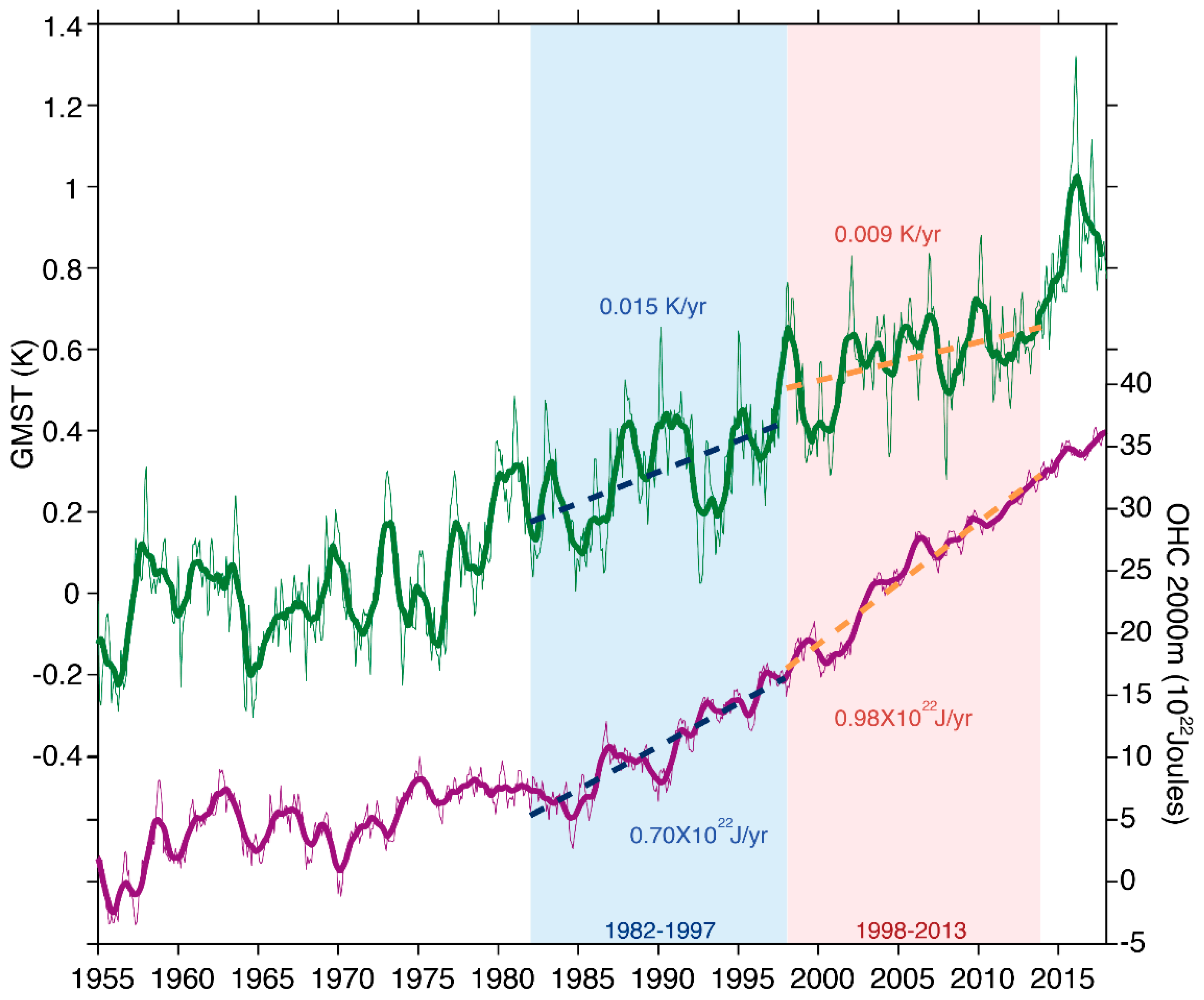
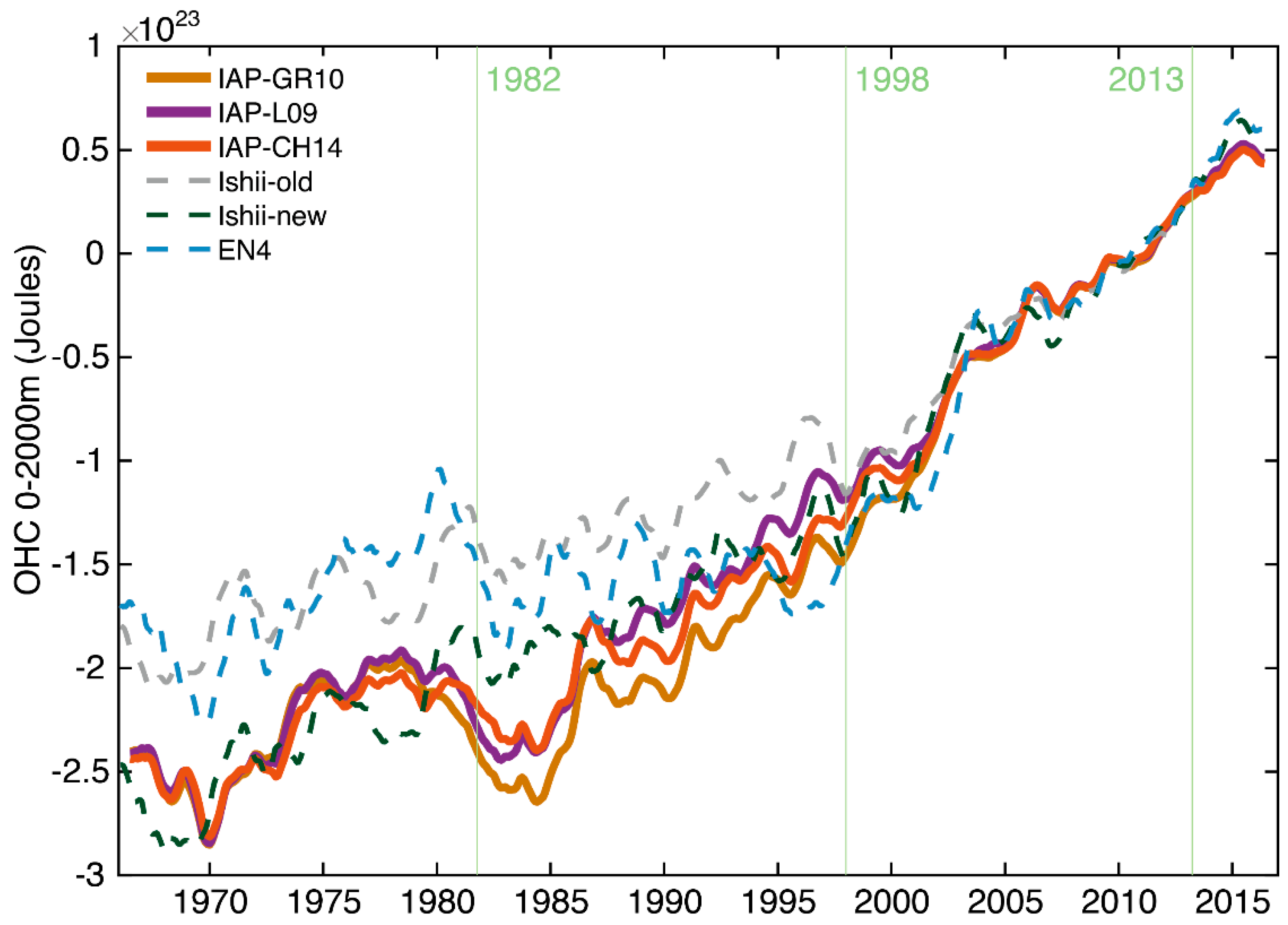
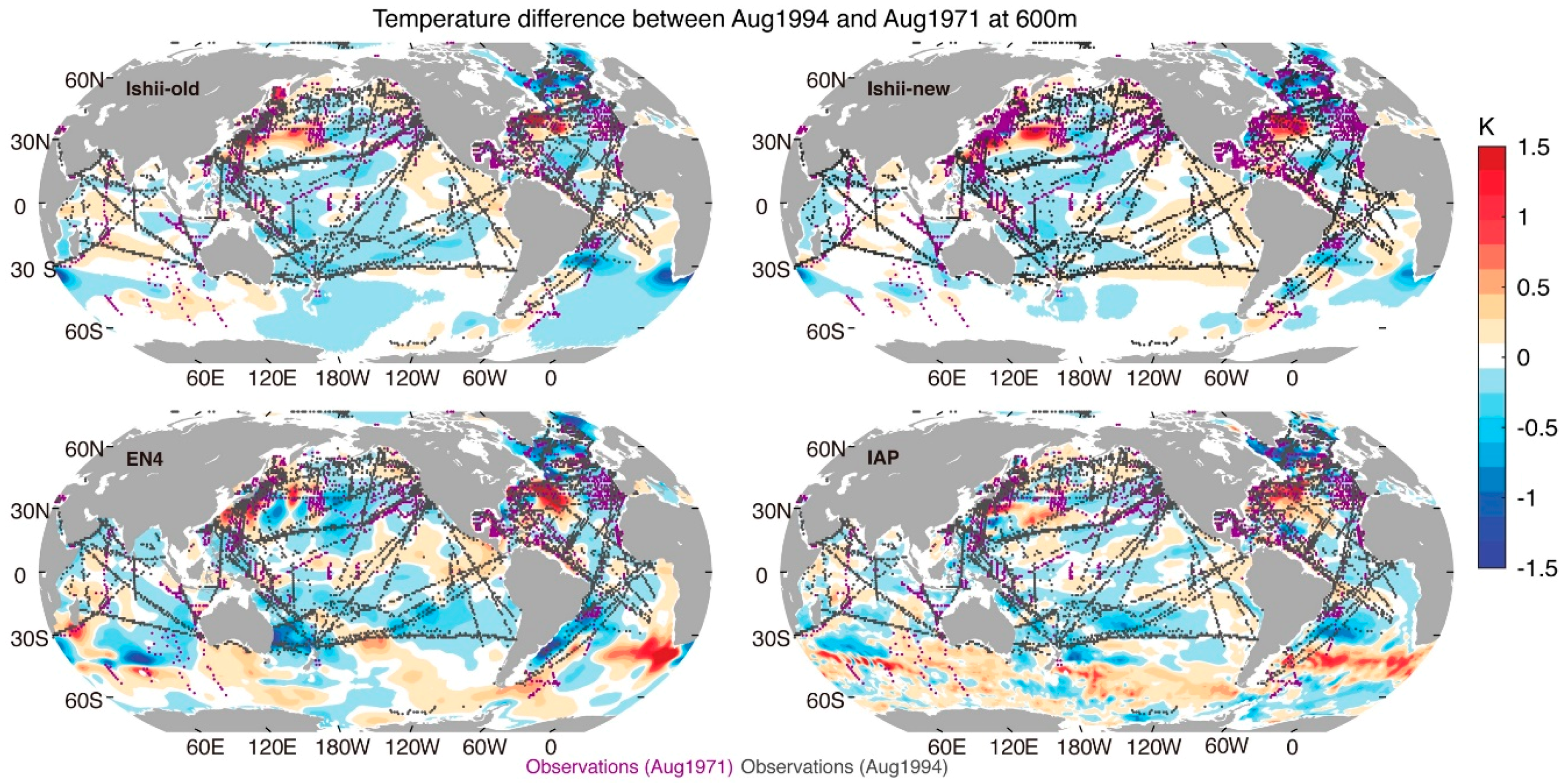
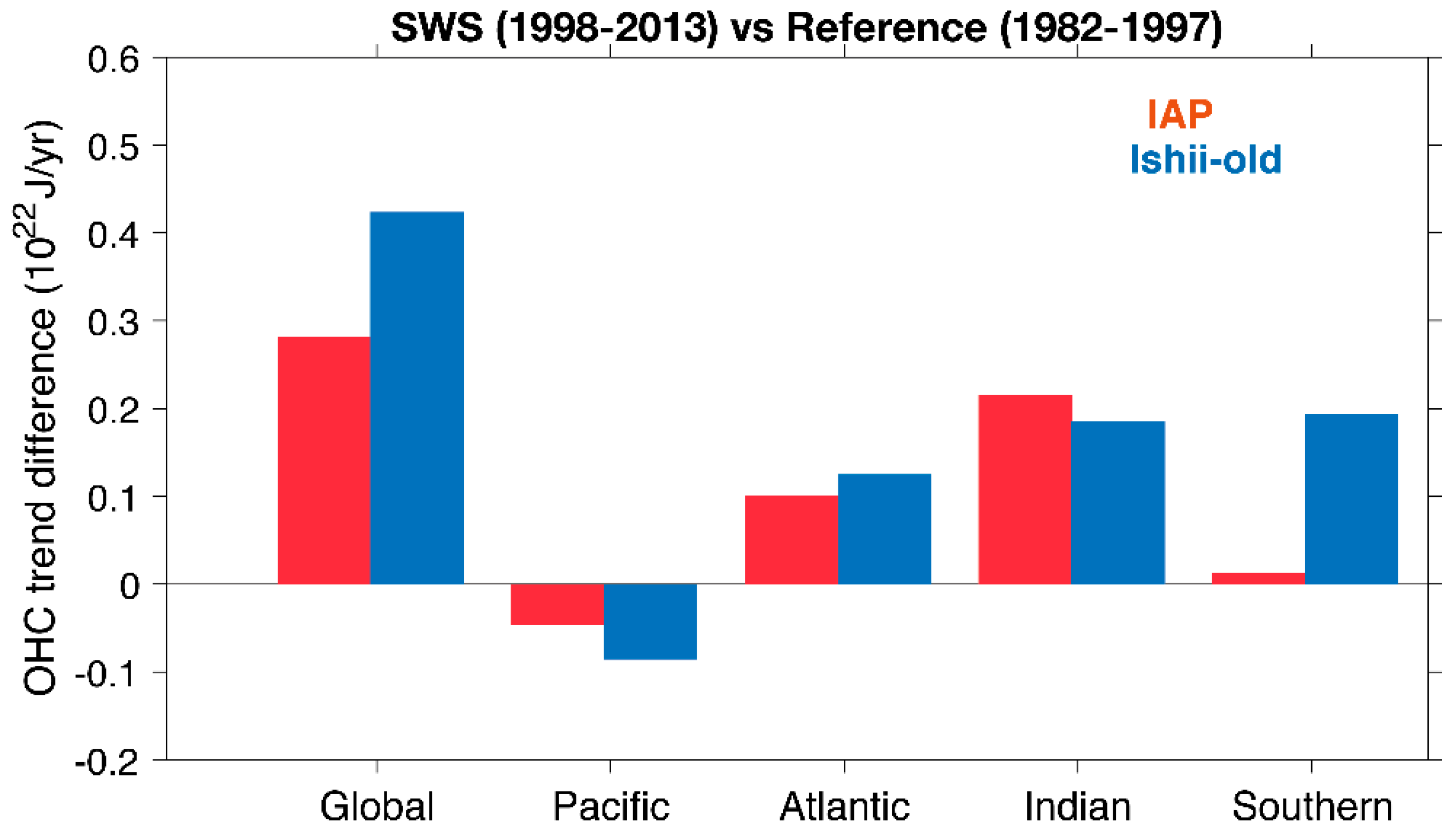
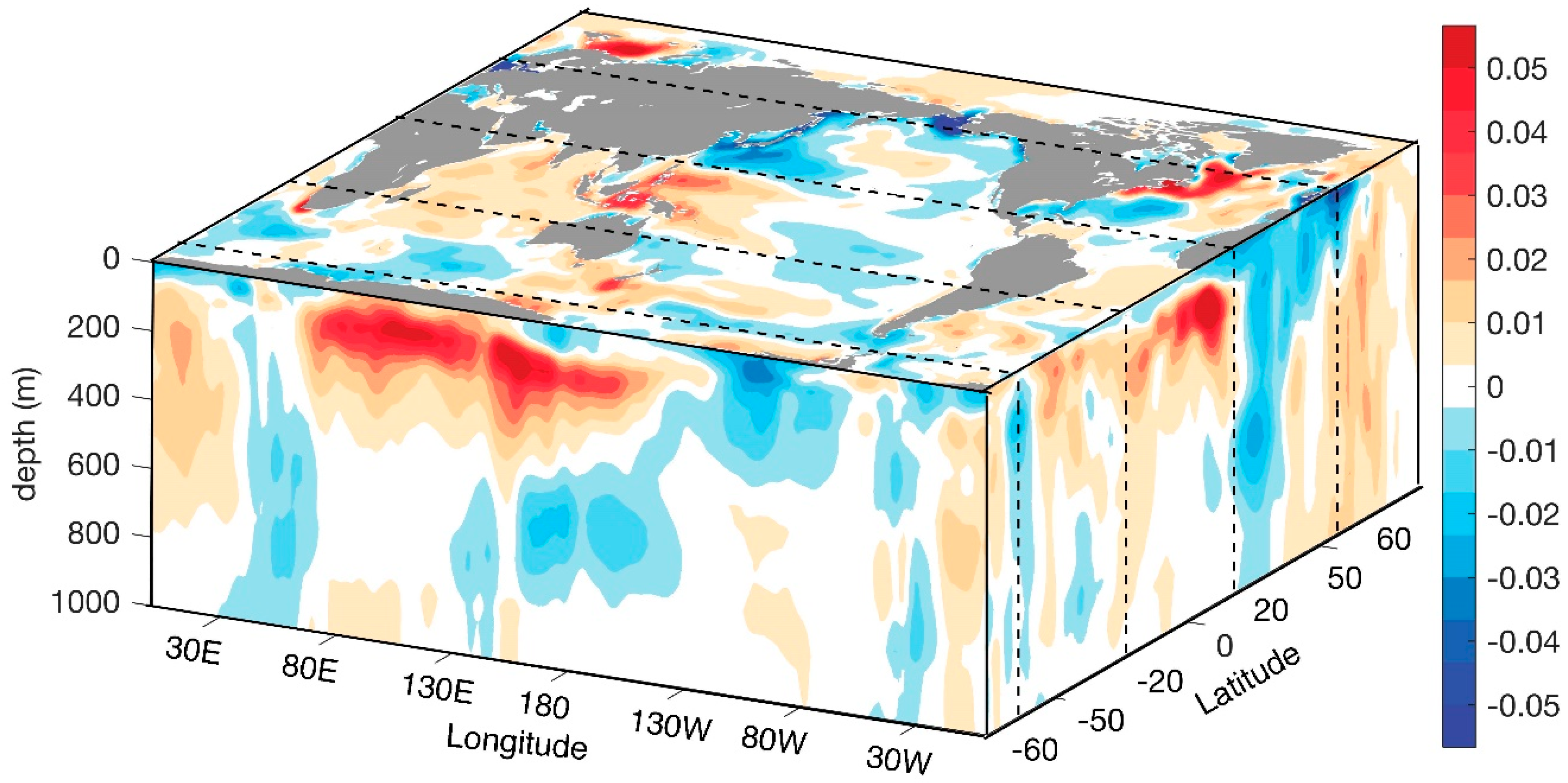
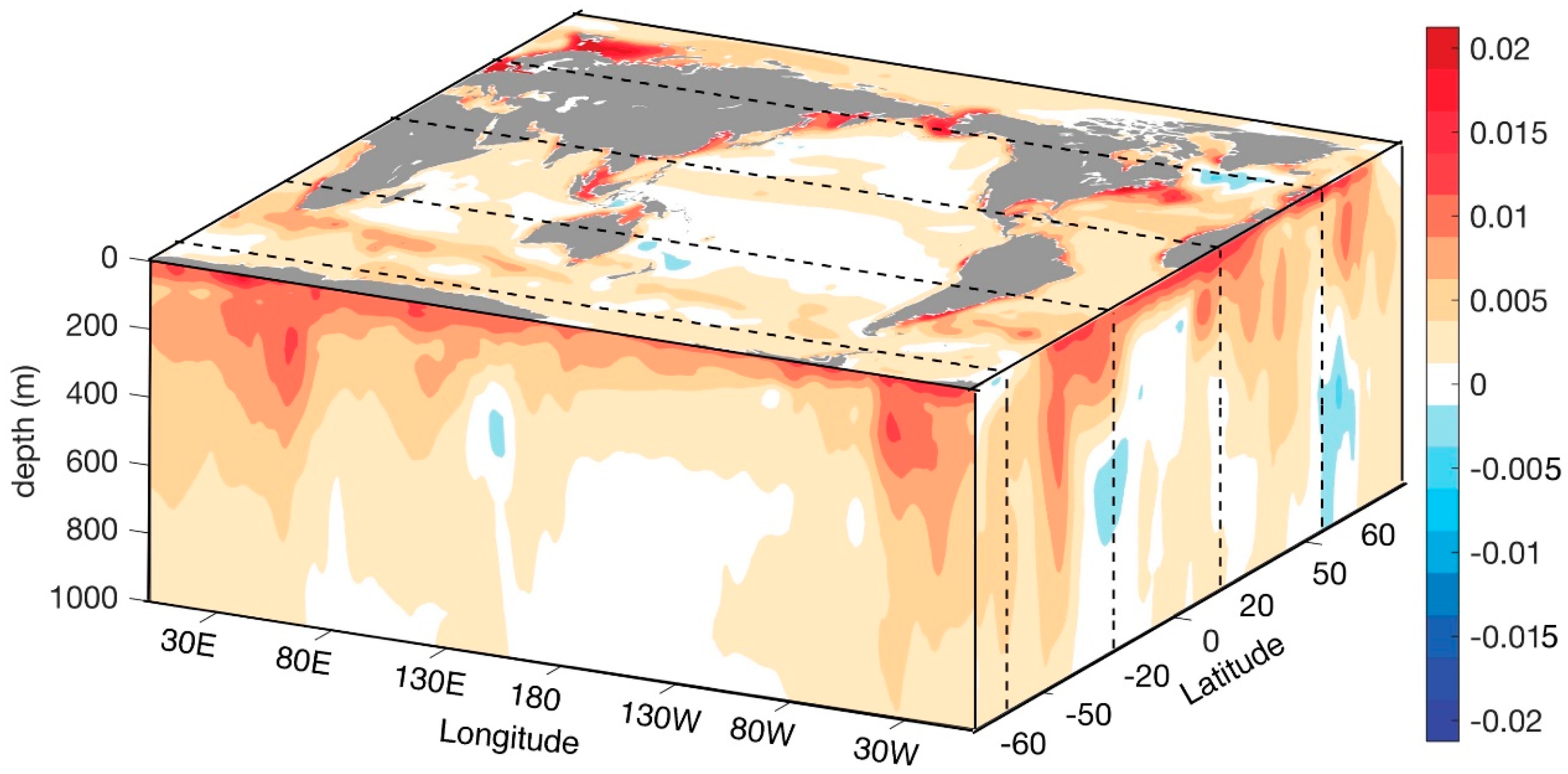
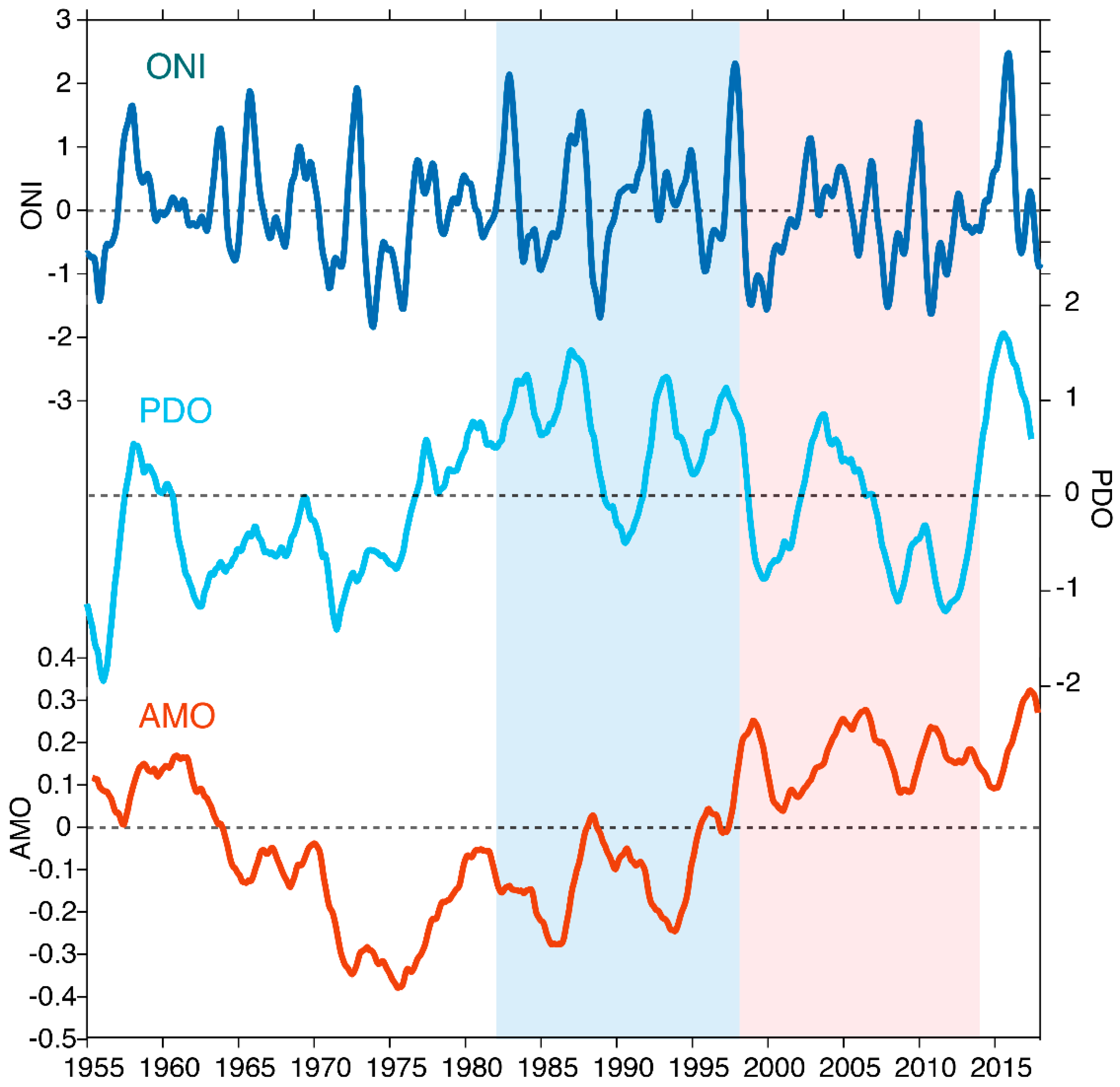
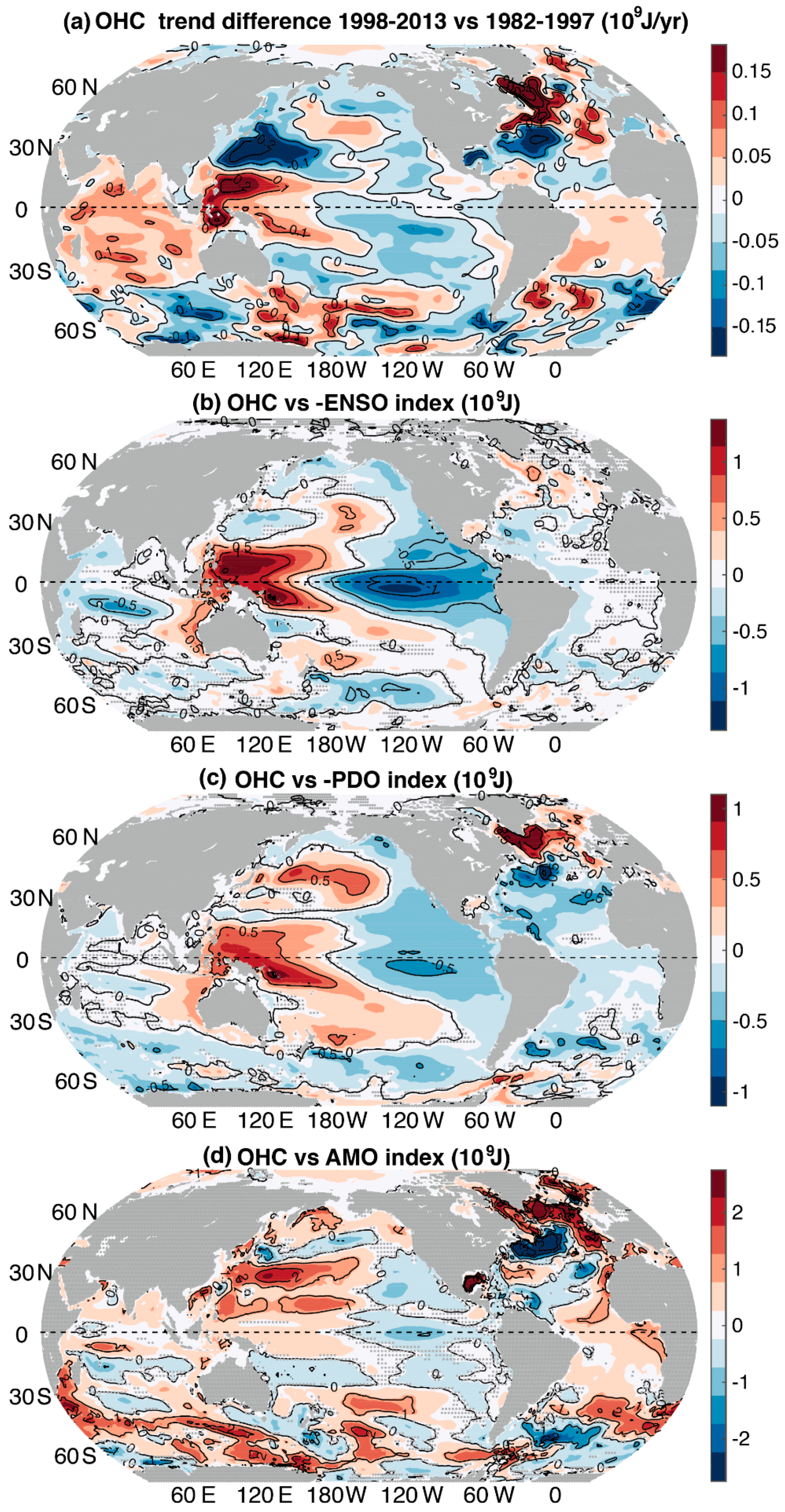
© 2018 by the authors. Licensee MDPI, Basel, Switzerland. This article is an open access article distributed under the terms and conditions of the Creative Commons Attribution (CC BY) license (http://creativecommons.org/licenses/by/4.0/).
Share and Cite
Cheng, L.; Wang, G.; Abraham, J.P.; Huang, G. Decadal Ocean Heat Redistribution Since the Late 1990s and Its Association with Key Climate Modes. Climate 2018, 6, 91. https://doi.org/10.3390/cli6040091
Cheng L, Wang G, Abraham JP, Huang G. Decadal Ocean Heat Redistribution Since the Late 1990s and Its Association with Key Climate Modes. Climate. 2018; 6(4):91. https://doi.org/10.3390/cli6040091
Chicago/Turabian StyleCheng, Lijing, Gongjie Wang, John P. Abraham, and Gang Huang. 2018. "Decadal Ocean Heat Redistribution Since the Late 1990s and Its Association with Key Climate Modes" Climate 6, no. 4: 91. https://doi.org/10.3390/cli6040091
APA StyleCheng, L., Wang, G., Abraham, J. P., & Huang, G. (2018). Decadal Ocean Heat Redistribution Since the Late 1990s and Its Association with Key Climate Modes. Climate, 6(4), 91. https://doi.org/10.3390/cli6040091






